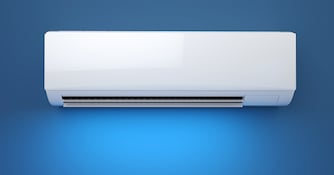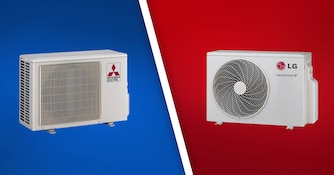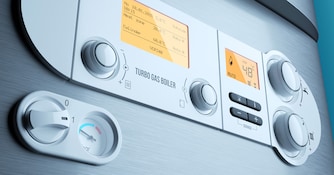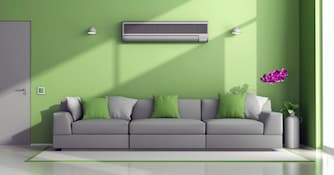
How to Get an Energy Efficient Air Conditioner and Heat Pump
Depending on your local climate, cooling your home in the spring and summer can get expensive. Unless you're into sweating, you'll need to run your air conditioner, which will eat up electricity. The same principle applies for using a heat pump during the colder seasons.
That's why finding an energy efficient air conditioner and heat pump is crucial to saving money. Efficiency tells you how much you get out of something versus how much you put into it. In the case of air conditioners and heat pumps, efficiency means how much heating or cooling you get for the amount of electricity used.
Two ratings are used to measure air conditioning and heat pump efficiency: SEER2 and HSPF2. We'll cover them in detail and explain how much you can save by switching to a higher efficiency level.
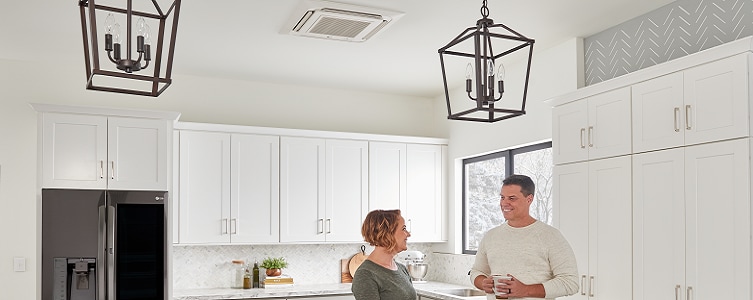
2023 New Minimum Efficiency Requirements
Beginning on January 1st, 2023 The U.S. Department of Energy (DOE) is raising minimum SEER, HSPF, and EER requirements. This includes updating the way efficiency is measured. To better reflect real-world conditions, the new efficiency testing procedures increase systems' external static pressure by a factor of five.
The result is a new scale of efficiency measurement. SEER becomes SEER2. EER becomes EER2, and HSPF becomes HSPF2. The table and map below indicate minimum ratings by equipment type and region.
The Southeast and Southwest regions are particularly impacted. After January 1st, 2023, air conditioning equipment not meeting the new minimum efficiency standards cannot legally be installed in those regions, even if you purchased it prior to that date.
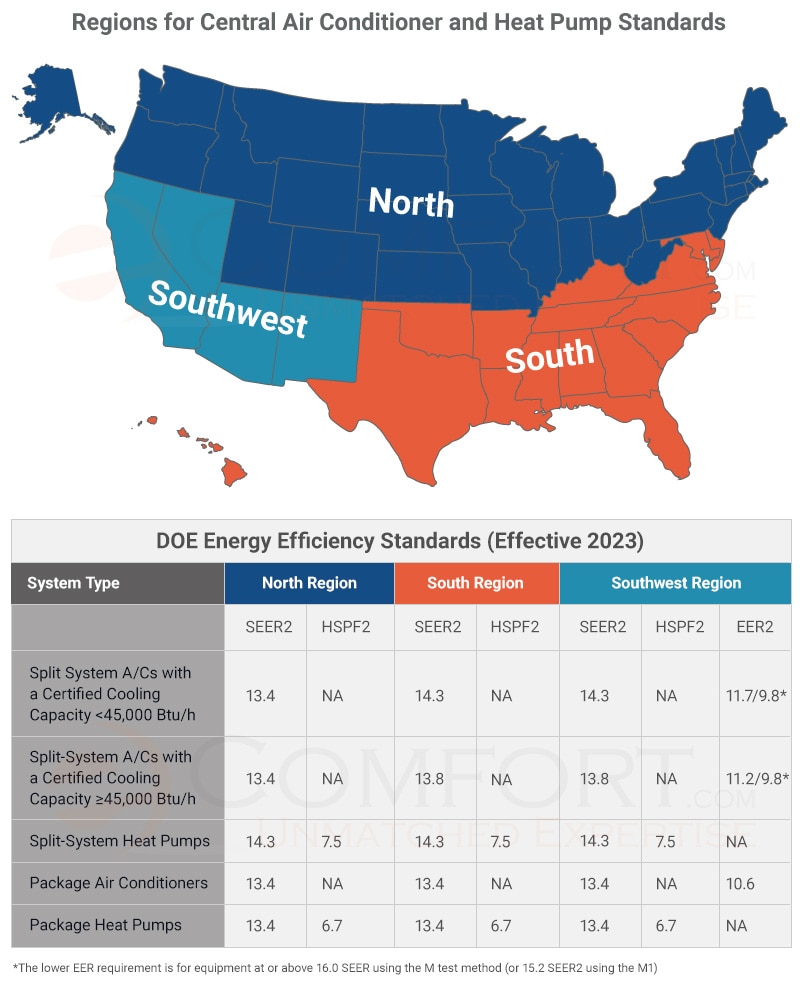
New Refrigerant Requirements
It's worth mentioning another major industry change. Beginning on January 1, 2025, residential HVAC equipment designed for R-410A refrigerant can no longer be manufactured. Most manufacturers are adopting R-454B or R-32 refrigerants to comply with the regulations. These are commonly referred to as A2L refrigerants, referencing their low flammability. Check out our new refrigerant guide to learn how this may impact you.
What is SEER2?
SEER2 stands for Seasonal Energy Efficiency Ratio and represents the amount of heat an air conditioner removes divided by the amount of electricity it uses. The more heat an AC unit can remove per kilowatt used, the higher its SEER2 rating.
Important to note is that SEER2 is a seasonal ratio that measures efficiency only in warmer months. SEER2 ratings DO NOT apply to how the equipment performs in winter.
SEER2 vs EER2: While the SEER2 rating will tell you how your unit will likely perform over the course of a summer, another rating, called EER2, is used to compare units while keeping conditions constant. Because of the conditions typically used during testing of EER2, EER2 often reflects efficiency at peak (although not necessarily extreme) use and, thus, is lower than SEER2.
Being seasonal, SEER2 is best for measuring efficiency in climates with a distinct warm season. EER2 is a better efficiency measure for air conditioners in more stable climates.
What is a Good SEER2 Rating?
Good SEER2 ratings will be above the minimum efficiency levels set by the DOE (see above). For central air conditioners, a good SEER2 rating is 16 and above. For ductless mini split air conditioners, a good SEER2 rating is 20 or more.
Use the SEER2 rating chart below to find out the percentage of savings you'll see by moving from a lower SEER2 piece of equipment to a higher SEER2. For example, if you upgrade from a 16 SEER2 air conditioner to a 17 SEER2 air conditioner, you will save an additional 6 percent on energy.
| Lower SEER2 | |||||||||
|---|---|---|---|---|---|---|---|---|---|
| 10 | 12 | 14 | 16 | 18 | 20 | 22 | 24 | ||
| Higher SEER2 | |||||||||
| 13 | 23% | 8% | |||||||
| 15 | 33% | 30% | 7% | ||||||
| 17 | 41% | 29% | 18% | 6% | |||||
| 19 | 47% | 37% | 26% | 16% | 5% | ||||
| 21 | 52% | 43% | 33% | 24% | 14% | 5% | |||
| 23 | 57% | 48% | 39% | 30% | 22% | 13% | 4% | ||
| 25 | 60% | 52% | 44% | 36% | 28% | 20% | 12% | 4% | |
| 27 | 63% | 56% | 48% | 41% | 33% | 26% | 19% | 11% | |
| 29 | 66% | 59% | 52% | 45% | 38% | 31% | 24% | 17% | |
| 31 | 68% | 61% | 55% | 48% | 42% | 35% | 29% | 23% | |
What is an HSPF2 Rating?
HSPF2 stands for Heating Season Performance Factor and represents the amount of heat that a heat pump adds to a space relative to how much electricity it consumes. In that sense, HSPF2 is the opposite of SEER2. The more heat that a heat pump produces per kilowatt used, the higher its HSPF2.
What is a Good HSPF2 Rating?
An HSPF2 higher than 9 is considered good. How high of an HSPF2 you go with should depend on how you plan to use your heat pump. If you live in a warmer climate and a heat pump will be your primary source of heating, then you should be fine with a lower HSPF2. On the other hand, if you live in a colder climate and won't be using your heat pump much, you should be fine with a higher HSPF2 since the unit will be working much harder.
All or Nothing
An especially important point to remember about efficiency is that, in an air conditioner, both the outdoor condenser coil and the indoor evaporator coil should be the same size. Both should have the same efficiency rating. If the indoor evaporator coil has a SEER2 of 17 but the outdoor coil has a SEER2 of 16, the whole system will have a SEER2 of only 16. The lesson here is not to mix and match equipment because the efficiency rating is only as good as the weakest link in the system.
Efficiency Matters
Choosing an efficient air conditioner or heat pump, whether it's ducted or ductless is important for saving you money and keeping you comfortable. In a world where the cost of everything keeps going up, take this opportunity to bring your cooling costs down.
